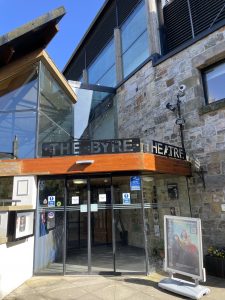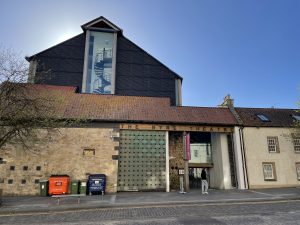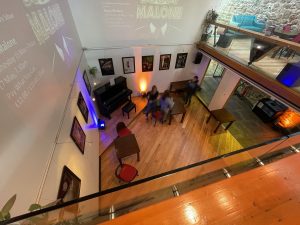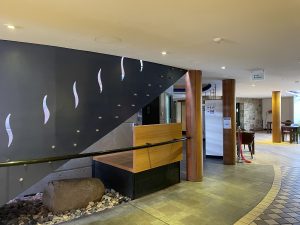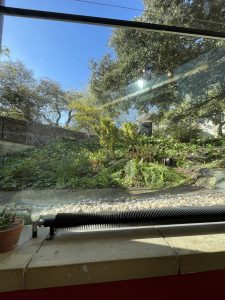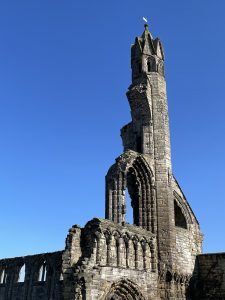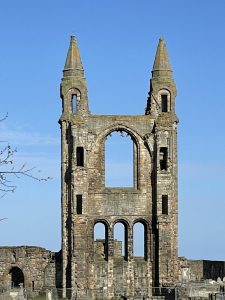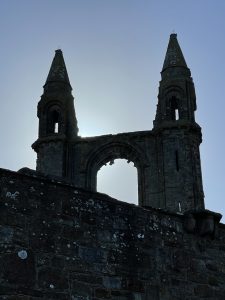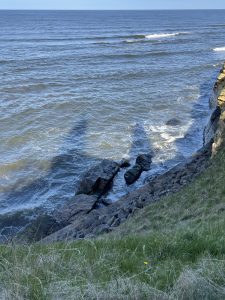I went to St Andrews in April to visit The Byre Theatre to understand its shape and character. I found a beautiful building, much larger than I had imagined from the initial photos that Jan* had sent me. The photos gave a good sense of the detail of the place but not of the scale of the building. I was intrigued by its having seemingly two entrances, one via a ‘wynd’ or narrow passageway from South Street, which takes you through a pretty garden to the Box Office entrance and the other, larger entrance on Abbey Street.
The latter looks more like the front of the building as it gives onto the street but it is where access to the back of the stage can be found, by means of a large sliding door for easy delivery of stage sets, equipment and so on. I’m writing this with hindsight, having understood much more about the building by now and the use of the different parts of the building were not apparent on this first visit.
I noticed a hushed interior with students seated at small tables getting on with their studies, mostly individually but some in small groups working quietly together. The place had an atmosphere of calm, rather like a library, which I am sure is quite different before and after a performance in the theatre with large numbers of people passing through.
I was able to move through the four levels using the iron staircase and travelling back down to ground floor, or Level One by means of the lift. I noticed wood, glass and stone as the primary materials but also metal, black ironwork in the detail. A sense of the outside coming in with a view to the small, sloping garden through the large double window on Level One.
What I hadn’t anticipated before arriving in the theatre was the rush of ideas I would have with this visit. Having spent almost three months immersing myself in Ernaux and beginning to devise work for the spaces and imagining what it might be but without first-hand knowledge of what it is like to be in that environment, a vacuum had formed into which the ideas flew, some ready-formed, taking their place in specific areas or corners and presenting themselves to me clear as anything so that I could see them in my mind’s eye. They sort of announced themselves to me, one after another, spreading their arms, looking at me and beaming “ta-dah! meet ME, I belong here” they seemed to say, pointing to a particular spot.
I came away from that visit with at least fifteen completely new ideas for pieces of work, whereas previous to my site visit I had been working to one main one. I couldn’t write them down or draw them quickly enough in my notebook.
My head full and feeling elated I left the Byre when it closed to the public at 5pm and took myself off to the sea, walking around the ruins of the cathedral with its imposing double-horned tower glaring down accusingly at me. As I negotiated the walkways and walls of these ruins of Reformation zeal I could feel a barely repressed Catholic energy emanating from their stones like the warmth from the Spring sunshine. It was a beautiful day, clear blue sky, fresh coolish air, a sweet breeze coming in from the sea. I stopped to look over the cliff edge down to the waves as they lapped the rocks below and saw the reflection of the tower on the surface of the water, like a fiendish beast, delineated by the setting sun caught behind the H of the ruined tower.
I brought that new stock of thoughts and ideas back with me and then was tasked with fitting them into the realm of possibility. A living, breathing, multi-functional building like the Byre, with its various constituencies of people using and inhabiting it has ‘go’ and ‘no-go’ zones and areas. I had mentally hung a sky-blue velvet curtain on the large white brackets of the large wall in the Abbey Street entrance, saw it waving in the sea breezes, erected fresh, wet, clay figures in amongst the stones of the sloping garden, seen them dissolve in the rain and become one with the ground, stood free-standing sculptures of varying dimensions and meanings on the different levels, viewable from ledges, balconies and when coming around corners. I had made a writing desk for Annie Ernaux on Level 4 with views out over the rooftops of St Andrews, filled the bookcase on Level 1 with a complete set of her works, in French and English.
My imagination and the possibilities on offer to it were limitless. One day, after the visit, I had a moment sitting on the sofa in our living room at home. I felt a door open onto a much larger world and imagined, for a moment, working to a much grander scale than I had previously. That is yet to come, for an appropriate place. For the time being, the human scale fits better with the safety and wellbeing of the people whose regular knowledge of the Byre takes precedence. But I’ve seen through that door and I can’t go back.
*Jan McTaggart, Deputy Director of The Byre Theatre
